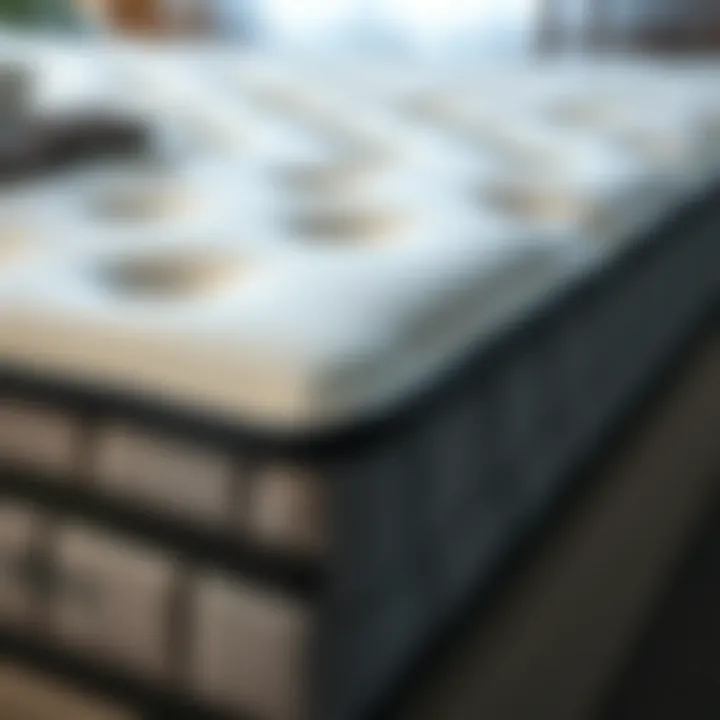Exploring Foam and Spring Hybrid Mattresses


Intro
In the ever-evolving landscape of sleep technology, foam and spring hybrid mattresses have emerged as a bridge between traditional innerspring beds and modern foam designs. These mattresses combine the support and durability of steel coils with the contouring comfort of memory foam or latex. This blend not only addresses the diverse sleeping preferences of individuals but also allows for personalized comfort and support. As homeowners or decorators explore the perfect mattress, understanding the nuances of foam and spring hybrids becomes essential.
Understanding the Anatomy
A hybrid mattress typically features a core of metal coils that provide foundational support and promote airflow. Surrounding this core are varying layers of foam, designed to cradle the body while distributing weight evenly. The interplay of these materials creates a unique sleeping experience that is both supportive and pressure-relieving.
Furniture Design Trends
Current Styles and Themes
When it comes to choosing a mattress, style isn’t the only consideration, yet an aesthetic choice can satisfy the visual elements of your bedroom. Many modern bedrooms embrace a minimalist theme, seeking mattresses that don’t just offer comfort but also blend seamlessly with simple decor. In this context, hybrid mattresses are often delivered in neutral colors and simple fabrics, allowing them to fit in effortlessly with contemporary furniture designs.
Color Palettes and Materials
The materials in hybrid mattresses range from cooling gel-infused foam to breathable organic cotton, catering to the growing consumer demand for eco-friendly products. Trends also lean toward sustainable sourcing, which encourages manufacturers to utilize materials that are not just comfortable but also environmentally responsible. Color-wise, whites, greys, and beige shades dominate, complementing the serene ambiance many homeowners strive for.
Practical Furniture Tips
How to Choose the Right Size
The size of your mattress can make or break your sleep environment. When selecting a hybrid mattress, consider the dimensions of your bedroom and how many people will regularly use it. A queen size is generally a safe pick, providing ample space for couples while still fitting in compact rooms. However, if you have the space, a king or California king can offer the ultimate in comfort.
- Measure your space: Ensure you leave room for other furniture, like nightstands.
- Test before you buy: Many retailers offer trial periods, encouraging you to sleep on the mattress for a few nights.
Maintenance and Care for Longevity
To prolong the life of your hybrid mattress, the right care routine is imperative. Regular turning and flipping (if applicable) can prevent wear in specific areas. It’s also advisable to use a mattress protector to ward off dust mites and spills, which can compromise the structure and comfort of the mattress over time.
"Regular care can extend the life of your mattress and improve sleep quality."
- Avoid jumping on the bed to prevent damage.
- Vacuum the surface regularly to maintain freshness.
End
In summary, foam and spring hybrid mattresses stand as an influential choice for anyone aiming to strike a balance between comfort and support. Not only do they harmonize with various interior design trends, but they also require thoughtful selection and maintenance, ensuring that homeowners and decorators alike can make informed choices. As you embark on the journey of finding the perfect mattress, remember to keep in mind the essential aspects of material, support, and style.
Intro to Hybrid Mattresses
In recent years, the landscape of sleep technology has grown increasingly complex, weaving together materials and innovations that cater to diverse preferences. Understanding hybrid mattresses is key to navigating this modern marketplace, especially as consumers seek enhanced comfort and value in their sleep investments. Hybrid mattresses, as the name suggests, combine both foam and spring systems, marrying the best of two worlds. This offering is not just a gimmick; it represents a thoughtful evolution in mattress design aimed at addressing the unique needs of a wide audience.
Defining Hybrid Mattress
At its core, a hybrid mattress blends the plushness of foam with the support of coils. Typically, it features a layer of pocketed coils, which—unlike traditional innerspring systems—move independently. This means they can contour to the body, promoting spinal alignment while reducing motion transfer, a common grievance for couples sharing a bed. Positioned above the coils are layers of various foams—often memory foam, latex, or polyfoam—that serve to cradle the body, providing pressure relief and comfort. Each component plays a vital role, ensuring that sleepers feel supported from head to toe while also enjoying a cloud-like experience. In essence, the hybrid mattress represents a harmonious relationship between resilience and softness.
The Evolution of Mattress Technology
The journey of mattress technology is not a short one. In the early days, simple straw and feather-filled mats dominated sleep solutions. Over time, advancements in materials led to the development of innerspring mattresses in the 19th century, followed by the introduction of foam mattresses in the mid-20th century. Memory foam, created from viscoelastic material, changed everything, providing significant pressure relief and body contouring capabilities. However, it wasn't until the fusion of these technologies—foam and springs—that the hybrid mattress emerged as a contender in the market.
"Hybrid mattresses combine advanced materials to offer a superior sleep experience, standing at the crossroads of tradition and innovation."
- The timeline of advancements includes:
- 1830s: Innerspring mattresses introduced.
- 1966: Birth of memory foam by NASA.
- 1990s: The first iterations of foam mattresses become mainstream.
- 2000s: Rise of the hybrid mattress, absorbing the best qualities of traditional and modern approaches.
Today’s hybrid mattresses continue to evolve, integrating new technologies such as adjustable firmness, cooling gels, and eco-friendly materials, further enriching the consumer experience. These innovations show an industry responding to demands for greater adaptability, sustainability, and comfort, ensuring that the hybrid mattress remains a relevant choice for discerning consumers.
Understanding Foam Materials
When delving into the world of hybrid mattresses, understanding foam materials is crucial. These components significantly influence comfort, support, and overall sleep quality. Different kinds of foam bring their unique benefits and drawbacks to the table, allowing consumers to tailor their mattress choice to their exact needs.
Types of Foam Used in Mattresses


Memory Foam
Memory foam is often touted as the star of the show in the realm of sleep technology. Its viscoelastic nature allows it to conform to the sleeper's body shape, providing unparalleled pressure relief. This unique property helps to distribute weight evenly and can alleviate discomfort for those with chronic pain conditions.
However, there’s a flip side: memory foam tends to retain heat. While this might not be a dealbreaker for everyone, hot sleepers often find it uncomfortable.
Key Characteristics:
- Contouring ability that matches body shape.
- Excellent pressure relief.
Advantages:
- Reduces pressure points.
- Efficient motion isolation, making it ideal for couples.
Disadvantages:
- Retention of heat for some individuals.
- May feel
Exploring Spring Systems
Spring systems are essential to understanding the dynamics of hybrid mattresses. They play a pivotal role in determining how well a mattress can support a sleeper while providing the comfort needed for a good night's rest. Unlike foam alone, which can often feel too soft or too firm depending on the density, springs offer a responsive support system that adapts to the sleeper's body shape and movements. This balance is crucial for various sleep positions and body types, effectively combining the best of both worlds: the stability of springs and the pressure-relieving properties of foam.
Types of Springs in Mattresses
Innerspring
Innerspring mattresses consist mainly of coils arranged in a grid pattern, providing both support and structure. The primary aspect of innerspring technology is the open design, which allows for more airflow compared to other systems. A key characteristic of innerspring mattresses is their resilience; they tend to regain shape quickly after pressure is applied, which can contribute to a feeling of bounciness that many users find preferable. This makes innerspring a popular choice for those who enjoy an element of responsiveness in their mattress.
However, there's a unique feature of innerspring mattresses that needs mention: the quality of the coils can vary significantly. Lower-quality coils may lead to discomfort over time, as they can sag and lose support. On the flip side, higher-quality coils can provide excellent enduring support, making sure you stay comfortable throughout the night. Thus, when considering an innerspring mattress, it's crucial to look for those made with high-quality materials.
Pocketed Coils
Pocketed coils, often referred to as independent coils, take innerspring technology a step further. Each coil is encased in fabric, allowing them to move independently of one another. This unique design helps eliminate the transfer of motion, meaning that if one partner moves around in bed, the other is less likely to feel it. The main advantage of pocketed coils is their ability to provide targeted support. For example, they can contour to the body more effectively, offering relief to pressure points.
An important characteristic of pocketed coils is their durability. They tend to last longer than traditional innerspring systems due to their individual movement and reduced wear and tear over time. However, they can be slightly more expensive than typical innerspring options due to the additional manufacturing processes involved.
Benefits of Spring Systems
Support and Bounce
A critical aspect of spring systems in hybrid mattresses is their ability to offer both support and bounce. This translates to proper spinal alignment, which is often mentioned as vital for a restful sleep. For those who are larger or heavier, the added support from springs can mean the difference between waking up refreshed versus waking up with aches and pains. The bounce from springs also aids in ease of movement on the mattress, providing more adaptability when changing positions during sleep. A major consideration here is that those who favor a more traditional feel to their mattress will likely appreciate the unique blend of support and bounce found in spring systems.
Temperature Regulation
Another significant benefit of spring systems is their role in temperature regulation. The open nature of innerspring and pocketed coils allows airflow that can help dissipate heat. For many sleepers, particularly those who tend to run hot, this feature can drastically affect overall comfort levels. While foam mattresses can trap heat, the spring systems help create a more temperature-neutral bedding experience. This is especially important during summer months, where overheating can disrupt sleep throughout the night. You’ll find that individuals who prioritize a cooler sleeping environment often lean towards hybrid options incorporating effective spring technology.
"Choosing the right spring system can tip the scales in favor of comfort and support, crucial for anyone looking to enhance their sleep experience."
For anyone shopping for a new mattress, understanding the different types of spring systems and their benefits can make all the difference in selecting the best option for your personal sleep needs and preferences.
Combination of Foam and Springs
The interplay between foam and springs in hybrid mattresses creates a compelling option for many sleepers. This combination leverages the best of both worlds, marrying supportive spring systems with the contouring comfort of foam. Understanding how these two materials work together is crucial in evaluating the benefits, effectiveness, and suitability of hybrid mattresses for various sleep preferences.
How Hybrid Mattresses Function
Hybrid mattresses function by integrating different materials to enhance overall performance. Foam layers typically rest atop a base of springs, allowing the mattress to adapt to the body's shape while providing the necessary bounce and support. The foam can vary in terms of type and density, affecting how well it cradles the sleeper's body and distributes weight.
The springs also play a vital role in maintaining structural integrity. They allow for airflow, which can improve temperature regulation, an important factor since foam tends to retain heat. The synergy between the two can make for a more comfortable, responsive sleeping surface, effectively reducing pressure points while ensuring sufficient spine alignment throughout the night.
Advantages of Hybrid Construction
Balanced Support and Comfort
The concept of balanced support and comfort lies at the heart of hybrid mattress design. With the right balance, these mattresses provide gentle cushioning without compromising support. This is particularly important for those who suffer from back pain or require specific ergonomic needs. The unique combination of foam's adaptability and the firmness of springs reduces discomfort and enhances sleep quality.


- Key Characteristic: The ability to contour while providing resilient support stands out. This characteristic makes hybrids popular among those who seek a quality night's sleep, as it aligns well with different body types.
- Unique Feature: Unlike traditional foam mattresses that might cause a sinking feeling, hybrids keep sleepers buoyant. This trait prevents the "stuck" sensation common in all-foam designs, allowing for easier movement.
Versatility for Different Sleep Styles
Versatility is another hallmark of hybrid mattresses—one size does not fit all when it comes to sleep styles. Whether you're a back, side, or stomach sleeper, hybrids accommodate various needs effectively. The adaptability of foam paired with the push from coils can cater to all sorts of preferences.
- Key Characteristic: The dual functioning nature means that the same mattress can support both light and heavy individuals comfortably, adjusting in the right areas without compromising the overall feel.
- Unique Feature: This adaptability extends to couples with differing sleep preferences, offering a potential solution for those whose needs might typically be at odds. Hence, hybrid mattresses can appeal to a wider audience than more specialized options available.
In summary, the combination of foam and springs in hybrid mattresses is a game-changer in the mattress market. It offers a compelling mix of support, comfort, and versatility that speaks to the needs of many different sleepers. The design promises to cater to individual preferences while tackling issues like temperature regulation and bodily support, making it a standout choice for those seeking a quality sleep solution.
Considerations for Choosing a Hybrid Mattress
In the vast landscape of sleep solutions, selecting the right hybrid mattress is not just a trivial decision; it’s a fundamental aspect of ensuring a restful night. With the swell of options available, it's crucial for individuals to pinpoint their specific sleep needs and preferences. Understanding these considerations will not only enhance comfort but also extend the life of the mattress, ultimately making every penny spent worthwhile.
Assessing Personal Sleep Needs
Choosing a hybrid mattress aligns closely with how well it meets your individual sleep needs. This isn’t a matter of personal taste alone; it delves deeper into understanding your body type and sleeping position, both pivotal in determining the best mattress for you.
Body Type
When it comes to body types, weight and shape play a significant role in how a mattress performs for you. For instance, heavier individuals might find that they sink too deeply into a softer mattress, which can lead to improper alignment and discomfort. In contrast, lighter sleepers may prefer a softer surface to provide the necessary cushioning.
The unique feature of body type considerations is its direct impact on pressure distribution. Heavier individuals often benefit from firmer options that provide support and keep the spine aligned. In contrast, those lighter in stature might appreciate something softer to cradle their body without compromising support.
Sleeping Position
Understanding your sleeping position is just as important as body type. The three primary positions—back, side, and stomach—demand different support systems. For instance, back sleepers usually thrive on mattresses that offer a medium-firm feel to maintain spinal alignment, while side sleepers might lean toward softer mattresses that relieve pressure on the hips and shoulders.
Each position carries its own characteristics and advantages. Side sleepers can find that a mattress with responsive foam aids in contouring. However, stomach sleepers often face challenges in maintaining spinal alignment, and thus may need firmer options that prevent excessive sinking.
Evaluating Firmness Levels
Choosing the right firmness level is essentially about finding that sweet spot between comfort and support. Hybrid mattresses often range from plush to ultra-firm. Firmness preferences can vary widely, so it’s wise to test a mattress in-store, even if it means removing your shoes and having a little lounge. Firmness levels not only influence comfort but can also impact sleep quality overall, making it a key consideration.
Understanding Temperature Sensitivity
Lastly, one cannot overlook the significance of temperature sensitivity when choosing a hybrid mattress. Some materials, particularly certain types of foam, are notorious for trapping heat. Meanwhile, traditional spring systems tend to promote airflow. A keen understanding of your body’s temperature regulation can assist in selecting a mattress that aids in a cool, comfortable sleep. Temperature control features, such as gel-infused foams or breathable covers, can significantly enhance sleep quality, particularly for those who sweat at night or simply run hot.
"A good night's sleep is not a luxury; it's a necessity. Choosing the right hybrid mattress can make all the difference."
Common Myths about Hybrid Mattresses
In the world of furniture and sleep solutions, hybrid mattresses stand at the intersection of comfort and support, blending the best features of both foam and spring designs. However, as with any evolving product, a few myths tend to cloud the perception around hybrid mattresses. When it comes to investing in a good night's sleep, it's essential to sift through these misconceptions, especially since they can significantly mislead potential buyers. By addressing these common myths, consumers can make more informed decisions and ultimately enhance their sleep quality.
Durability and Lifespan
One prevailing myth surrounding hybrid mattresses is their durability. Many people assume that because a mattress combines foam and springs, it tends to wear out quicker than traditional innerspring models. In reality, the lifespan of a hybrid mattress largely depends on the quality of materials used and the care it receives over time. A well-constructed hybrid bed can last around 7 to 10 years, which is on par with premium innerspring or all-foam mattresses.
It’s important to look for key indicators of durability:
- Quality of materials: High-density foams tend to offer better longevity.
- Construction techniques: Properly encased coils can resist sagging.
- Warranty: A solid warranty often reflects the manufacturer's confidence in their product quality.
To debunk the durability myth, consider researching brands that prioritize quality. Many manufacturers even highlight their materials to emphasize robustness. Such evaluations reveal that a hybrid is often a long-term investment rather than a short-term choice.
Comfort Misconceptions
Another common misconception is that hybrid mattresses are uncomfortable due to their complex construction. Some prospective buyers worry that the various layers may create a bumpy or uneven sleeping surface. However, this notion is far from the truth. Hybrid mattresses are engineered to provide balanced support and comfort, combining the pressure relief from foam with the responsive support of springs.
The comfort level of a hybrid mattress can actually be quite customizable. It caters to various sleeping styles—whether you sleep on your back, side, or stomach. Common benefits include:
- Pressure relief through the top foam layer, helping to alleviate discomfort for side sleepers.
- Support from innerspring coils, ensuring the body remains aligned regardless of posture.
- Motion isolation, especially from pocketed coils that react independently to movement, creating a serene sleep environment even with a restless partner.
In essence, the combination of foam and springs allows for a tailored sleep experience. When shopping for a hybrid mattress, it’s wise to test out different models to find the right fit that aligns with your personal comfort preferences.
"Don’t just believe the hype or horror stories; lay down the cash and lay down on the mattress. You might be surprised at how much you like it."


Frequently Asked Questions
Frequently asked questions (FAQ) help guide the understanding of hybrid mattresses, often addressing common concerns and misconceptions. In the sphere of sleep products, clarity is essential, especially when the stakes involve one's comfort and health. The FAQ section in this article provides insights directly drawn from consumer experiences and expert opinions, ensuring that readers can grasp what impacts their mattress choice.
Some of the specific elements this section tackles include:
- Lifespan of hybrid mattresses, making it essential for buyers to know how long their investment may last.
- Suitability for various sleep styles, addressing whether hybrid mattresses can accommodate multiple sleeping positions and preferences.
Through these discussions, the article aims to demystify key points of confusion for prospective buyers, aiding them in making informed decisions.
How Long Does a Hybrid Mattress Last?
Hybrid mattresses bring together the best of both foam and spring technologies, resulting in durability and comfort. The lifespan of these mattresses tends to range from 7 to 10 years, sometimes longer if maintained well. Each element in a hybrid mattress plays a role in its longevity:
- Foam Layer: Depending on the type of foam used, such as memory or latex, the durability can vary. Higher-density foams often last longer, resisting wear and deformation.
- Spring System: The quality and type of springs, particularly pocketed coils, enhance not just support but also resilience. Old-fashioned innerspring mattresses might sag sooner than modern pocket coil designs.
- Maintenance: Regular rotation and the right bed frame can affect a mattress's lifespan significantly. Customers may want to invest in protective covers to further prolong life.
It’s not only about how long a mattress lasts but also how it performs during its life. Look for signs of wear, like sagging or decreased responsiveness, which might indicate it’s time for an upgrade.
Are Hybrid Mattresses Suitable for All Sleepers?
The adaptability of hybrid mattresses makes them a popular choice for many, but are they truly suitable for every type of sleeper? The short answer is yes, with some important considerations. These mattresses cater to a diverse range of sleeping styles:
- Side Sleepers: The foam layers provide the gentle cushioning needed to relieve pressure on shoulders and hips, while the springs offer essential support to keep the spine aligned.
- Back Sleepers: The combination of foam and springs helps maintain natural spinal curvature, providing the necessary support and comfort.
- Stomach Sleepers: While some stomach sleepers might find hybrids suitable, it’s crucial to choose a firmer model. This helps prevent excessive sinking, which can lead to back pain.
In summary, hybrid mattresses can indeed suit varying sleeping preferences. However, selecting the right level of firmness and support tailored to one's sleep position is key.
"The right mattress is not just about comfort; it’s about ensuring restful sleep that rejuvenates the mind and body."
For more detailed insights and recommendations, readers can explore resources such as Sleep Foundation, where experts dive deeper into sleep surface suitability and performance.
Trends in Hybrid Mattress Development
The development of hybrid mattresses has seen considerable changes in recent years, as innovative technologies seek to align consumer expectations with comfort needs and sustainability trends. Understanding these trends is crucial for making informed choices that resonate with both personal comfort and ecological responsibility.
New materials and methods are being introduced, targeting the demands of modern sleepers. Today's homeowners, decorators, and retailers are increasingly opting for products that not only promise a good night’s sleep but also adhere to sustainable practices. As environmental concerns take precedence, knowing the ins and outs of these trends can empower consumers to choose wisely.
Sustainability Factors
Sustainability is now more than just a buzzword; it's become a fundamental principle in mattress manufacturing. Consumers are growing more aware of the impacts their purchases have on the planet, leading companies to adopt eco-friendly materials and processes. For example, many hybrid mattresses now incorporate organic cotton and eco-friendly foams that are manufactured without harmful chemicals.
This approach not only reduces the environmental footprint but also caters to those with sensitivities to allergens. Using natural materials can lead to healthier sleep environments, ultimately benefiting the user's well-being.
Here are some key elements to consider regarding sustainability in hybrid mattresses:
- Materials: Brands are now sourcing latex from sustainable rubber trees, promising not just durability but also ethical production.
- Certifications: Look for certifications such as GOTS (Global Organic Textile Standard) or OEKO-TEX, which ensure that the materials used meet strict environmental and health standards.
- Recyclability: Some newer designs are being engineered for easier disassembly and recycling at the end of their lifespan, minimizing landfill waste.
"As consumers become more environmentally conscious, the push for sustainable products in the mattress industry is likely to grow in strength and presence."
Technological Innovations
Keeping pace with advancements in technology has proven to be a game changer for hybrid mattresses. Features like adjustable firmness, smart technology integration, and enhanced cooling mechanisms are increasingly popular among manufacturers.
For those seeking the perfect combination of support and comfort, some newer models employ adaptive foams that conform precisely to an individual's body shape, providing targeted support where it's most needed. Additionally, temperature regulation technology, such as cooling gel memory foam or phase change materials, has emerged to address the discomfort that can come from overheating during sleep.
Key innovations to look out for include:
- Smart Mattresses: Integrated technology in mattresses can track sleep patterns and adjust firmness during the night for optimal comfort.
- Cooling Technologies: Enhanced ventilation and moisture-wicking materials are being used more frequently, promoting a cooler sleeping environment.
- Health Monitoring: Some designs offer features that can monitor user health statistics, allowing individuals to make data-driven decisions about their sleep habits.
End: Making Informed Choices
Making informed choices when it comes to selecting a mattress—especially a foam and spring hybrid—goes beyond mere comfort. It's about aligning your sleep environment with your personal needs and preferences. This discussion emphasizes the importance of understanding factors that contribute to a good night's sleep and how hybrid mattresses stack up against traditional options.
First and foremost, it's essential to consider individual body types and sleep positions. A mattress that provides optimal support for a side sleeper may not offer the same comfort for a back or stomach sleeper. Hybrid mattresses often strike a balance by combining various materials. Thus, they can cater to diverse sleeping styles. Evaluating firmness is another critical aspect. The right level of firmness can help maintain spinal alignment while ensuring pressure relief—especially for heavier individuals seeking adequate support.
Moreover, knowing how sensitive you are to temperature can greatly impact your selection. Hybrid mattresses usually feature breathable materials, aiding in heat dissipation. This can keep you cool, even during warmer nights.
Summarizing Key Points
- Understanding Personal Needs: Identify your body type, sleeping position, and preferences for firmness.
- Evaluating Durability and Comfort: Different materials like memory foam and pocketed coils offer unique solutions to comfort and support.
- Temperature Sensitivity: Consider how the mattress regulates heat, especially in varying climates.
- Focus on Quality: Instead of settling for lower-priced options, invest in a quality mattress that supports your long-term health needs.
Informed decisions lead to better sleep experiences. By being cognizant of your unique requirements and the properties of hybrid mattresses, you'll ensure a healthier night's rest and enhance your overall quality of life.



